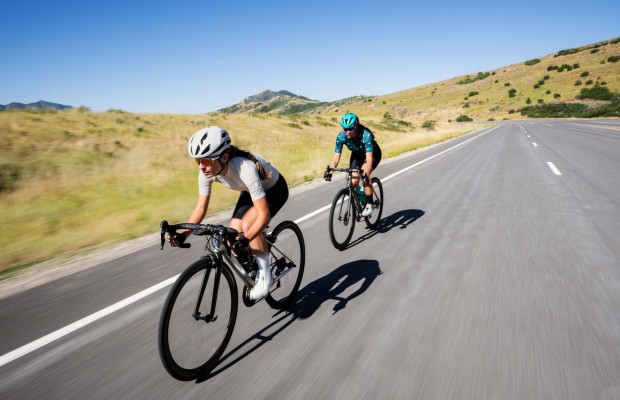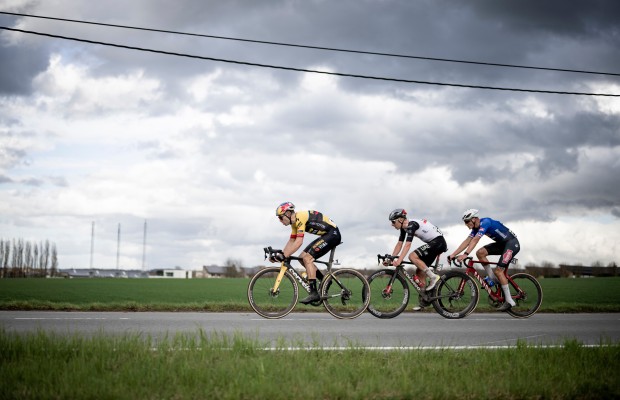What caused the crash in the Itzulia, is it necessary to find someone to blame?
After the dramatic massive crash that occurred in the Itzulia, with very raw images of cyclists like Jay Vine or Jonas Vingegaard lying motionless on the ground and being evacuated by ambulance, the cycling world wonders if situations like yesterday's are avoidable or who is responsible for it happening, all with conflicting opinions amplified by the social media megaphone among which, however, we find a few nuggets of wisdom.

Cycling safety questioned after serious crash in Itzulia
When a serious fall occurs in cycling, voices quickly rise criticizing the race organization for the chosen route. In fact, we have recently seen the organization of Paris-Roubaix preemptively addressing the issue, giving in to pressure from the Professional Cyclists Association and modifying the entry to the legendary Aremberg sector with a solution that may be worse than the problem it seeks to solve.
The fall that occurred in the Itzulia on the descent of the Alto de Olaeta, with about 40 kilometers to go. A road that locals are very familiar with and did not hesitate to comment on. Shortly after the incident, we could read opinions like that of former cyclist Joseba Beloki, who commented on social media, "those of us from the area know that curve very well. At first glance, it seems easy due to the angle, but it is very complicated due to the road surface. Internal roots that surprise you in the middle of the turn.".
RECOMENDADO

Tips for getting up early to ride

Complete list of the highest paid cyclists of 2025

Shimmy Effect: why some bikes become uncontrollable when going downhill

How many calories are burned when cycling

What is heart rate variability and how does it affect the cyclist?

Fat Max Training to efficiently eliminate fat

Similarly, Euskaltel-Euskadi cyclist Mikel Bizkarra commented, "On that road, there are a lot of tree roots under the asphalt that make the road very bumpy. You can't see them, but without realizing it, you're bouncing, and if you don't hold the handlebars tightly, it's 'easy' to go flying.".
With this background, it is easy to blame the organization for including such a section in the route, however, as seen in the broadcast before that curve, there were warnings signaling the dangerous section. We must consider that situations like the ones described, even with roads in worse condition, are common on mountain roads, except in races like the Tour de France, which with its economic power can afford to partially pave many of the mountain passes it crosses. We have to accept that mountain roads are what they are, and in fact, it is part of their essence.
Opinions have also quickly emerged, even at the finish line after the stage, placing the blame for what happened on the cyclists themselves and on how cycling races unfold today. Undoubtedly, the clearest speaker was Pello Bilbao, explaining how it is a constant in races for all teams to want to be grouped with their leaders at the front of the race while explaining that the peloton entered that curve very fast. These are situations that, according to him, should make the cyclists themselves reflect.
#Itzulia2024 | Interview with Pello Bilbao after crossing the finish line. Talking about everything that happened.
— Le Puncheur (@LePuncheur_) April 4, 2024
"I think it has to make us cyclists reflect".
@lauramtaberner pic.twitter.com/swEleus5lA
Other former professionals like Nicholas Roche also pointed out that the technical evolution of bikes and the increasingly better aerodynamics are responsible for the increase in falls in the peloton, as they lead to faster speeds. When combined with the fact that disc brakes can stop the bike in less space, everything adds up to reduce the reaction time left for cyclists, and at higher speeds, the consequences of falls are more severe.
In any case, everyone acknowledges that falls are an inherent part of cycling and that, in most cases, they are simply unavoidable without affecting the development of this sport. It is clear that if you take the race on three-lane highways, on sunny days, with clean and dry pavement, no wind, and flat terrain, there are fewer falls, but is that really the cycling we want to see?
See this post on InstagramAdvertising
Perhaps the solution to all this lies in demanding greater protection of the routes from the organizers, something that has improved in recent years, and it is not uncommon to see many curves and complicated areas protected with mattresses or reinforcing the signage, even with luminous panels as Flanders Classics has been implementing in its races. Another way to improve safety would be to focus on developing cyclist protection systems, such as the airbag cycling shorts we mentioned in this article, which minimize the consequences of falls without interfering with the cyclist's performance.
Incidents like the one we experienced in the Itzulia serve to propose these improvements and continue advancing, a process that must be done carefully to not lose the essence of this sport in which, whether we like it or not, risk is part of the game, and all cyclists understand that descending a mountain pass at 80 km/h or fighting for position in a peloton traveling at over 60 km/h is inherently dangerous.